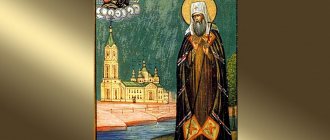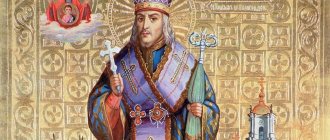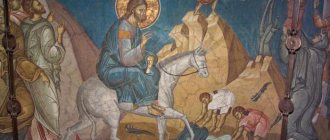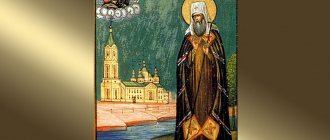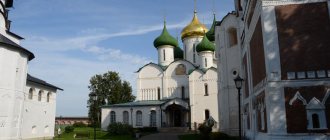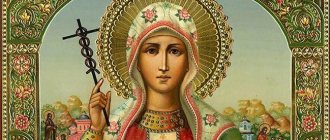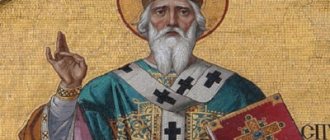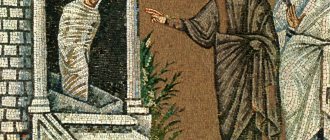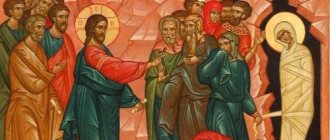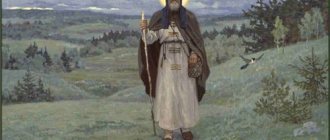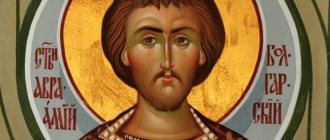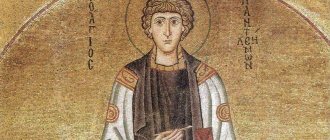| St. Mitrofan Voronezhsky. Icon. |
Mitrofan
, in the schema
Macarius
(1623 - 1703), Bishop of Voronezh and Yelets, Saint Memory of August 7 (glorification in 1832), September 4 (second discovery of the relics in 1964 and transfer in 1989) [1], November 23, 19 July in the Cathedral of Three Russian Saints [2]), June 4 (namesake; Voronezh.), April 2 (bishop's consecration in 1682; Voronezh.), December 11 (appearance of the relics in 1831; Voronezh.) [3], in Cathedrals of Vladimir, Voronezh, Ivanovo, Kostroma, Lipetsk and Starobelsk (Ukrainian) saints
In the world, Mikhail Vasilyevich, was born on November 6, 1623 in the village of Antilokhovo [4], Kovrovsky district, Vladimir province (now Savinsky district, Ivanovo region) in the pious family of priest Vasily and Maria [5].
Until the age of 40, the future saint lived in the world, was married, had a son, and served as a parish priest in the village. Sidorovsky, located near the city of Shuya.
Already at this time he established himself as a good shepherd, a gentle and caring father.
In 1663, having become a widower, he went first to the Nikolo-Shartomsky monastery, and then to the Zolotnikovskaya Assumption hermitage in Suzdal district, where he took monastic vows in honor of St. Mitrofan, Patriarch of Constantinople [6]. The monastery that received the ascetic was very poor, but he fell in love with it for the rest of his life and even wanted to be buried in it.
In June 1665, the brethren of the Yakhroma Kosmin Monastery elected him as their abbot. In 1666, Metropolitan Paul III of Sarsky elevated him to the rank of abbot of the Yakhroma Kosmin Monastery. In this monastery, Abbot Mitrofan built a new temple in the name of the All-Merciful Savior, His Image not made by hands [7]. For almost 10 years he ruled the said monastery, instilling a spirit of piety among the brethren, and being jealous of the external beautification of the holy monastery.
In 1675 he was transferred to the abbot of the Makariev Unzhensky Monastery, on the Unzha River, Kostroma diocese, which he ruled for almost seven years. Here he built a warm church in honor of the Annunciation of the Blessed Virgin Mary and decorated it with church utensils and icons. The new church was consecrated in 1680.
The pious and ascetic life of Abbot Mitrofan promoted him to the post of archpastoral service.
At the Council of 1681-1682, to combat the growing schism, a new department was established - Voronezh, where Mitrofan was elected as the first bishop.
On April 2, 1682, he was consecrated Bishop of Voronezh. The ordination in the Moscow Great Assumption Cathedral was performed by Patriarch Joachim with 16 saints. It was attended by: Cornelius, Metropolitan. Novgorod and Velikolutsky, Markell, Metropolitan. Pskov and Izborsk, Nikifor, Metropolitan. Astrakhan and Tersky, Evfimy (Rylkov), Metropolitan. Sarsky and Podonsky, Pavel (Marovsky), Metropolitan. Ryazan and Murom, Filaret, Metropolitan. Nizhny Novgorod and Alatyr, St. Simeon (Molyukov), Metropolitan. Smolensk and Dorogobuzh, St. Hilarion, Metropolitan Suzdal and Yuryevsky, Jonah (Sysoevich), Metropolitan. Rostov and Yaroslavl, Simon, Metropolitan. Vologda and Belozersky, Jonah (Baranov), Metropolitan. Vyatka and Velikoperm, Sergius (Veltakhov), archbishop. Tverskoy and Kashinsky, Afanasy (Lyubimov), archbishop. Kholmogorsky and Vazhsky, Nikita (Totemsky), Archbishop. Kolomna and Kashirsky, Gelasius, Archbishop. Veliky Ustyug and Totemsky, Leonty, bishop. Tambovsky and Kozlovsky [8]
After his consecration, the saint lived in Moscow for several months, arranging the affairs of the new diocese. During his life in Moscow, he had to participate in the burial of the deceased Tsar Feodor Alekseevich and the crowning of the young sovereigns John and Peter.
At the end of August 1682 he arrived in Voronezh. The population of the region in those days was heterogeneous. Taking advantage of the fact that the region was removed from the center of civil and spiritual power, people from all over Russia flocked here, seeking freedom or hiding from punishment. The clergy were almost entirely illiterate, but there were still not enough such clergy - some churches were closed due to the lack of pastors. The monasteries were in a state of disrepair. The monks were more subordinate to lay people - the benefactors of the monasteries - than to the archpastoral authority. This situation contributed to the spread and strengthening of the schism in the diocese. The schismatics felt at ease in the Voronezh region, attracting the population to their side, they either led them into schism or distracted them from going to church.
The saint had to wage a persistent and difficult struggle against the moral disorders that abounded among his willful flock. He directed special attention to strengthening family life, placing the foundation of the family—marriage—under the strict supervision of the church.
From the very first steps of life in Voronezh, difficulties began. Due to the dilapidation of the bishop's house, the saint was at first forced to live in an inn. Diocesan funds were very meager and the saint was not only unable to give alms to those in need, but he himself was in very straitened circumstances; all the inhabitants of his bishop’s house were in need. One of the first concerns of Bishop. Mitrofan was the construction of a new cathedral. With the blessing of the patriarch and with donations from sovereigns and other persons, the church was built and consecrated in 1692. The temple was remarkable both in architecture and in its interior decoration, and the saint loved it as his brainchild. His love for temple building was passed on to his flock. During his priesthood in the Voronezh diocese, the number of churches increased from 182 to 239.
The bishop was given a lot of trouble. Mitrofan, the schismatic Old Believers who inhabited his diocese and tempted his flock to apostatize from the Orthodox Church. Saint Mitrofan dealt with schismatics according to the harsh laws of that time, sending opponents of the church to the “city court.” But he didn’t stop there. He selected old printed books and distributed new ones, ordered priests to teach constantly in churches, and he diligently preached sermons. In different villages of the Voronezh diocese under St. Schools arose in Mitrofan.
In 1696, it began to be called “Voronezh and Azov”, in connection with the inclusion of newly conquered lands around Azov under its omophorion.
| Saint Mitrophan of Voronezh |
Particular attention should be paid to the relationship between bishops.
Mitrofan and Tsar Peter I. St. Mitrofan treated the sovereign with special love and respect, he sympathized with all his good undertakings, and provided all possible assistance in the construction of the fleet. Not only did he himself have a personal favor towards the king, but he also encouraged others to do the same. Tsar Peter, in turn, respected the saint and contributed greatly to strengthening the newly established poor Voronezh diocese. When visiting Voronezh, the sovereign always visited the saint and was present at the services. With such a disposition towards the king, Saint Mitrophan remained firm when matters concerned the souls of the flock entrusted to him. In 1700 (during one of the sovereign’s visits to Voronezh), the tsar invited bishop. Mitrofan to his palace. The saint immediately went on foot to the king. But upon entering the courtyard, he saw at the entrance to the palace statues of Greek gods and goddesses, placed as decoration by order of the king. The saint immediately turned and went home. The king was informed about this. He sent a man to him a second time with orders to appear. But the saint replied: “Until the sovereign orders the removal of the idols that seduce all the people, I cannot enter his palace.” He was so adamant in his decision that even the threat of the death penalty from the tsar did not frighten the saint. Tsar Peter usually never compromised on his innovations, but respect for the saint forced him to give the order to remove the statues. The next day St. Mitrofan came to the palace to thank the sovereign. In 1700, the title of archpastor was changed to “Voronezh and Yeletsk” [9] in connection with the formation of an independent Azov diocese.
In his cell life, Bishop Mitrofan was simple to the point of squalor; his entire household routine was distinguished by exceptional modesty. He ate the simplest food and dressed just as simply. He used all his income for the needs of his diocese and mainly for thanksgiving. After him there was no money left even for burial, although recently the income of the Voronezh saint was considerable. He wrote in his will: “But I don’t have cell money... the imam has neither gold nor silver in his cell to give for the remembrance of my sinful soul.”
The saint’s favorite and constant thought was the thought of death. “Mortal memory”, like a faithful guardian, protected the saint’s heart from attachment to the temporary and perishable, and instilled in him the hope of the eternal. This same constant thought about death also explains a touching feature in the life of the saint - his concern for the memory of all those who died an unknown and bitter death, who died in war and in poverty, without repentance and who did not have the opportunity to commemorate themselves.
In August 1703, Saint Mitrofan fell ill and, feeling that his illness was fatal, began to prepare for his death. He received the sacrament of unction several times, intensified his care for those in need, sent generous alms to prisons, helped exiles and foreigners, and forgave taxes.
On August 10, 1703, he was tonsured into the schema and named in honor of St. Macarius of Zheltovodsk, Unzhensky.
Died on November 23, 1703. He was buried in the Annunciation Cathedral on the 12th day after his death. Tsar Peter was present at the burial of the saint. At the end of the funeral service, the king himself carried the saint’s coffin and lowered it into the grave. He said to his entourage: “I don’t have such a holy elder left.”
A few years before the death of St. Mitrofan composed a spiritual will, in which he gives pastoral instructions for all Christians: “Use work, keep moderation, and you will be rich. Drink abstinently, eat little, and you will be healthy. Do good, avoid evil, and you will be saved.”
During the renovation of the Annunciation Cathedral, the relics of the saint were transferred twice (in 1718 and 1735). Each time the incorruption of the body of St. was witnessed. Mitrofan. From that time on, reverent veneration of St. began. Mitrofan and the miraculous manifestations of God's help at his grave increased.
Since 1820, it was noticed that the number of admirers of the memory of St. Mitrofan flocking to Voronezh increased enormously. The signs of grace also increased. Archbishop Anthony (Smirnitsky) of Voronezh repeatedly reported to the Holy Synod about miracles and asked permission to glorify the saint. The Holy Synod ordered observation of the gifts of grace received at the tomb of St. Mitrofan.
In 1831, the incorruptible relics of the saint were witnessed by the Right Reverend Anthony, together with members of the commission of the Holy Synod, Archbishop Eugene of Yaroslavl (?) [10] and Archimandrite Hermogenes of the Spaso-Andronievsky Moscow Monastery.
On November 23, 1832, Saint Mitrofan was canonized. His memory was established to be celebrated on August 7, on the day of his repose, and on November 23, on the day of his glorification.
In the Voronezh diocese, Archbishop Anthony (Smirnitsky) established the following celebrations in honor of St. Mitrofan: June 4, in memory of St. Mitrofan, Patriarch of Constantinople, is the name day of St. Mitrofan, Bishop of Voronezh; April 2 is the day of the episcopal consecration of St. Mitrofan (in 1682 .) and December 11 - on the occasion of the appearance of the relics of St. Mitrofan (in 1831).
During a large-scale campaign to liquidate holy relics, on February 3, 1919, the relics of St. Mitrophan of Voronezh were uncovered.
Popular legend has preserved some details of the mockery committed over the honorable remains of the Saint. On February 3, 1919, before the start of the liturgy, the leaders of the local Bolshevik cell, accompanied by a large crowd of Red Army soldiers and security officers, entered the Annunciation Cathedral of the Mitrofanovsky Monastery. They announced to the clergy, the brethren of the monastery and numerous pilgrims the decision of the “working people”: “to put an end to the priest’s fables about holy relics.”
. The Red Army soldiers pushed the believers away from the shrine of the Saint and took out the cypress coffin with the relics. The proposal of Bishop Tikhon (Nikanorov) to extract the relics himself was rejected by them. The atheists with ridicule began to pull off the shrouds and coverings from the Saint, then the holy relics raised on bayonets were demonstrated to everyone.
The monastery brethren and pilgrims cried, unable to stop the lawlessness. Hegumen Vladimir reassured the brethren: “The great mercy of God was shown to the Saint - to endure martyrdom for Christ at the end of his earthly life.”
. Having committed the desecration, the atheists drew up an autopsy report. They included the honorable remains of Saint Mitrofan in the inventory of the cathedral property as “socialist property” and left it in the cathedral [11].
Brief biography of the saint
The path of Mikhail, who became the bishop of the Russian Orthodox Church, was always illuminated by faith. The adoption of monasticism was deeply meaningful.
Origin and worldly life
Mikhail was born into the family of a priest who had a parish in the Vladimir province. The service of the church was passed down from generation to generation, so Mikhail also became a village priest. After some time, he married one of the parishioners, and they had a son, Ivan.
The beginning of the monastic path
The life of Mitrofan of Voronezh begins with the death of his wife. He became a widower when he turned 40. It was this event that brought him to the walls of the monastery, where he took monastic vows. Mikhail took a monastic name, he called himself Mitrofan. The future saint really liked life in the Zolotnikovskaya hermitage, but three years later the brothers from the Yakhroma monastery asked him to become abbot. After several years of service, he was appointed abbot of the Unzhensky Monastery.
Bishop of Voronezh
At the beginning of 1675, Mitrofan was granted the rank of archimandrite. Under Mitrofan, the monastery became especially famous for observing strict rules and raising ascetic monks. The Patriarch spoke about the monastery when he wanted to give an example of proper administrative management, skillfully combined with compliance with all church rules. Tsar Fyodor Alekseevich loved to come to the abbot of the Unzhensky Monastery. He asked the abbot to pray with him or spent long hours quietly talking with Mitrofan.
For several decades, the Russian Orthodox Church experienced a schism. The strengthening of the church apparatus began with the provincial dioceses. At this time, Mitrofan was appointed Bishop of Voronezh. The initiator of this was Fyodor Alekseevich, who was a supporter of the formation of the Voronezh diocese as separate from the main diocese.
The Voronezh bishop made every effort to smooth out the consequences of the quarrel between Orthodox believers. He tried to convert the Old Believers to the faith, but if they disobeyed, he did not persecute them, but allowed them to live in peace.
Saint and Peter the Great
Mitrofan of Voronezh often emphasized that the Orthodox Church should help the state. Thanks to his views, the bishop became close friends with Peter the Great. During the construction of the fleet on the territory of Voronezh, the bishop called on the population to make donations for the military treasury.
The Life describes the incident when Peter the Great called the bishop to his palace. Mitrofan refused the king, although he was warned about the power of the king's anger. The reason for the refusal was that pagan statues brought by the king from European museums were preserved in the palace. The authority of the saint was so high that Peter ordered the statues to be removed only so that the bishop could enter the palace. Peter often consulted with him and called him a “holy elder” during his lifetime.
Illness and death
Mitrofan lived to a ripe old age. Before his death, he was tonsured into the schema and called himself monk Macarius. Until his last breath, the bishop maintained a clear mind; his illness did not change him. During his illness, he consciously prepared for his own funeral. I thought through the smallest details. The only thing he was never able to do was lie in a coffin in the simple attire of a monk who had accepted the schema. After his death, the newly-minted Macarius was dressed as an archimandrite and carried in a coffin to the burial place by Peter the Great himself.
Spiritual testament
Mitrofan of Voronezh was a good preacher; during the service he read many texts that were written in his own hand.
Before his death, Mitrofan left a spiritual will, where he spoke about the need to read the Holy Scriptures and follow God's laws.
Mitrofan's words were recorded by his disciples; they formed part of the Life, which was begun during the life of the elder by one of the hieromonks of the Voronezh diocese. The spiritual testament has been preserved to this day; it is located under glass on the shelves of the State Historical Museum.
Miracles through prayers
A large number of miraculous healings and unique phenomena are associated with the image of St. Mitrofan, Bishop of Voronezh. Let's look at just a few of them:
- A landowner from the city of Lipetsk, Ivan Ladygin, suffered from a serious illness. The man could not move or get out of bed. One day the weak man was brought to the relics of the saint, where a miracle happened: Ivan Ladygin got rid of excruciating pain throughout his body and began to move around with the help of crutches.
- A year later, Ivan Ladygin’s daughter fell ill from the event described above. After a fever, the girl fell into a coma. The Bishop of Voronezh appeared to her in a dream. Soon the child, who received the archbishop's blessing, began to recover.
- A blind man was brought to the wonderworker's tomb. The blind peasant rubbed his eyes twice with oil from the lamp that burned near the icon of the saint, and immediately received his sight.
- The local deacon's wife was possessed. A woman named Agafya tried to commit suicide several times. Tired of his wife’s demonic attacks, the deacon forcibly brought her to the Church of God and placed the robes of St. Mitrofan in her hands. Agafya lost consciousness. When the woman regained consciousness, she felt light and free - the demon had been expelled from her soul and body.
Many miracles and healings are associated with the image and relics of the saint.
Discovery of relics and canonization
Annunciation Cathedral, where St. Mitrofan of Voronezh, was reconstructed twice. During repairs, the tomb was moved to a new location, but witnesses noted the incorruptibility of the elder’s relics. The church records two dates for the veneration of Mitrofan, they indicate the first and second discovery of the relics. 1832 was the year of canonization of Mitrofan of Voronezh. The relics are still in the Annunciation Cathedral in Voronezh. Pilgrims from all over the country travel to the location of the holy relics of Mitrofan.
Iconography
The iconography of the saint is very extensive. And these are not only icons, but also his mosaic images and images in the form of a fresco. These images include:
- mosaic temple image above the entrance to the Moscow Church of Mitrofan of Voronezh in Petrovsky Park;
- mosaic image of St. Mitrofan of Voronezh on the eastern facade of the Kazan Church in Voronezh;
- painting in the Assumption Church in the Trinity Macarius Zheltovodsk Monastery in the Nizhny Novgorod region;
- mosaic icon of St. Mitrophan of Voronezh on the southern portal of the Cathedral of St. Nicholas the Wonderworker in Kronstadt (St. Petersburg);
- a fragment of the painting of the vault of the Resurrection Cathedral in the Sretensky Monastery in Moscow, a bas-relief on the old clergy house of the Annunciation Church in Petrovsky Park in Moscow;
- painting in the narthex of the Church of the Yelets Icon of the Mother of God in the city of Yelets, Lipetsk region.
This is not the entire list of holy images of this kind. As for the iconographic images of the saint, they depict him in dark blue or black priestly vestments, with a bishop’s staff in his left hand. With the right hand of St. Mitrofan blesses all those praying at his holy image. There are icons where St. Mitrofan is depicted together with St. Tikhon Zadonsky.
Believers turn to the saint with prayers for the healing of mental and physical illnesses, for help to loved ones, for the well-being of children, for the material well-being of the family, for work, and for the strengthening of faith.
“St. Mitrofan gives us today an example of piety, an example of love and care, an example of a good business executive and organizer of church and state life, an example of meekness and humility, zeal for God. He gives us many examples. God grant that we take at least one example from his life into our arsenal, and try today to do at least some good deed, imitating the saint of God...”
Archbishop Arseny.
Temples
Several churches named after Mitrofan of Voronezh were built on the territory of the country:
- Moscow church at the shelter of Elizabeth Feodorovna;
- a church on the territory of the Tentelevsky cemetery in St. Petersburg (the cemetery is called Mitrofanyevsky);
- Pskov Temple, originally founded as a monastery.
On the way to Christ
Saint Mitrophan of Voronezh, according to his own recollections, came from a pious Christian family. He was born on the territory of the Vladimir province, November 6, 1623.
Little is known for certain about the childhood and youthful years of the life of Saint Mitrofan. In the world he was called Michael, he was brought up within the Orthodox traditions, in the spirit of goodness, love of God and trust in the Church. Having reached adulthood, he got married, had a son, Ivan, and had warm paternal feelings for him. Left without a wife, in the fortieth year of his life he renounced the vanity of this world and entered the Zolotnikovsky hostel monastery, located near the city of Suzdal. It is assumed that Mikhail's own father belonged to the clergy.
Having made a choice in favor of monasticism and entered the monastery, Mitrofan humbly and zealously fulfilled the obediences assigned to him, prayed a lot, and God was to help him. Over time, the fame of Mitrofan's exploits and virtues spread beyond the monastery and spread throughout the area.
The brethren of the neighboring monastery, Yakhromskaya, understanding him as a zealous, spiritually experienced ascetic and not having an abbot at that time, began to ask the church authorities to install him as abbot over them. This request was also supported by the monastery peasants. The management, finding a rational grain in this, went to meet them halfway.
Lyrics
To contact Bishop Mitrofan of Voronezh, choose one of the publicly available texts. They are read at church prayer services or at home in front of the icon.
Troparion
You were the rule of faith, the image of meekness in words, in your life, to your flock, the humbly wise Father Mitrofan. Moreover, in the brightness of the saints of the sun, you have shone most brightly, we adorn you with the crown of incorruption and glory, pray to Christ our God for our country, your city, to be saved in peace.
Kontakion
Having enslaved the body to the spirit by abstinence, having created the soul equal to the angels, you clothed yourself with holy clothes, like the crown of the priesthood, now, standing before all, pray to the Lady, the all-blessed Mitrofan, to pacify and save our souls.
Greatness
We magnify you, our holy father Mitrofan, we honor your holy memory, for you pray for us, Christ our God.
Prayer
Saint Father Mitrofan, through the incorruption of your honorable relics and the many good deeds that you have miraculously done and performed with faith, flowing to you, convinced that you have received great grace from the Lord our God, we all humbly fall down and pray to you: pray for us (names) of Christ our God May He bestow upon all who honor your holy memory and diligently resort to you His rich mercies: may He establish in His holy Orthodox Church the living spirit of right faith and piety, the spirit of knowledge and love, the spirit of peace, joy in the Holy Spirit, and all its members , are clean from worldly temptations of carnal lusts and the evil actions of evil spirits, in spirit they worship Him in truth and are diligently concerned about keeping His commandments for the salvation of their souls.
May her shepherds give holy zeal to care for the salvation of the people entrusted to them, enlighten the unbelievers, instruct the ignorant, enlighten and confirm those who doubt, convert those who have fallen away from the Orthodox Church into her holy bosom, keep believers in the faith, move sinners to repentance, console and strengthen those who repent. in the correction of life, those who have repented and corrected themselves will be confirmed in the holiness of life: and thus everyone will be led along the path indicated by Him into the prepared eternal Kingdom of His saints. To her, the saint of God, may your prayers arrange all that is good for our souls and bodies: may we glorify in our souls and bodies our Lord and God, Jesus Christ, to Him, with the Father and the Holy Spirit, be glory and power forever and ever.
O Saint Father Mitrofan! Accept this small prayer from us, sinful servants of God (names), who come running to you, with your warm intercession, beg the Lord our God, Jesus Christ, that having looked upon us mercifully, He will grant us forgiveness for our voluntary and involuntary sins and deliver us from troubles, sorrows, sorrows, mental illnesses and physical illnesses that overwhelm us; may everything contribute to the benefit of our present life; May He grant us to end this temporary life in repentance and may He grant us, sinners and unworthy, His Heavenly Kingdom, to glorify His endless mercy with all the saints, with His Beginningless Father, His Holy Life-giving Spirit, forever and ever. Amen.
Hegumen activity
In 1663, Mitrofan was elevated to the rank of priest and ordained abbot. In this position, he showed himself to be a caring, loving mentor, and a kind leader. While engaged in the spiritual education of the brethren, he paid a lot of attention to the improvement of the monastery.
In the first year of reigning the monastery, Father Mitrofan acquired a richly decorated Gospel. Then, resorting to donations from philanthropists, he organized the construction of a new, more spacious temple than the existing one.
The pastoral zeal, initiative and good organizational skills of Abbot Mitrofan did not escape the attention of Patriarch Joachim, and he offered him the position of abbot in the more famous Zheltovodsk (Unzhensky) monastery. Father Mitrofan humbly accepted this offer. He ruled this monastery for about seven years. During the period of his leadership, the monastery was transformed: the beautiful Annunciation Church was rebuilt, with a bell tower and a refectory; many icons were painted. But the main thing: his activities contributed to the spiritual transformation of the brethren.
Sovereign Feodor Alekseevich, having respectful feelings for Father Mitrofan, had communication with him. Some representatives of the royal court had similar feelings towards the abbot.
In 1682, in accordance with the decision of the Moscow Council of 1681, the Voronezh diocese was formed. Since schismatic sentiments intensified among the people at that time, it was clear that the new diocese should be headed by a strong-minded, wise and zealous shepherd. The tsar chose the abbot Mitrofan, whom he revered, to take this place. The church leadership approved and supported the idea.
Bishop's Way
On April 2, 1682, Patriarch Joachim solemnly consecrated Father Mitrofan as Bishop of Voronezh.
The death of Tsar Theodore, who died shortly after this event, caused the delay of Saint Mitrophan in the capital. In addition, he had to be present at the ceremony of crowning two Alekseevichs: John and Peter; During this ceremony, Saint Mitrofan presented a crown on a platter, which was then placed with prayer on Peter’s head.
In addition, Bishop Mitrofan took part in the Council, organized against the outrages of the schismatics that took place in the Chamber of Facets.
Arriving at the place of his episcopal service, the saint addressed through a district letter to the subordinate clergy, where he called on the clergy to strict observance of the faith and a responsible attitude towards the flock. As part of the message, he highlighted three most important aspects in the management of Christ's flock: by word, sacred rites and prayers, and personal example.
Considering the scale of the rampant schismatic sentiments in the country, from the very beginning of his ministry, Saint Mitrofan set the task of fighting for church unity. He saw the basis of unity within the flock in the unity of faith and obedience to the voice of the Church.
Among the first things to do in his department, Bishop Mitrofan organized the construction of a new stone church in Voronezh. Construction lasted about fifteen years. All this time the bishop served in a wooden church. When the work was nearing completion, to everyone’s regret, it turned out that during construction mistakes were made due to the insufficient experience of the masons, and the temple building was considered unreliable.
In the spiritual and moral area, Saint Mitrofan showed himself to be a kind and merciful bishop. They note that he was available not only to close and dignitary persons, but to everyone, including commoners; The usual part of the ministry for the saint was visiting prisoners in dungeons; in addition, he showed special concern for orphans and widows.
The financial situation of the Voronezh department left much to be desired. The fact is that the receipt of funds for diocesan needs strongly depended on the number and size of parishes, while the Voronezh diocese was significantly inferior to others in this regard. It happened that conflicts occurred between the authorities of the Ryazan and Voronezh clergy regarding a number of churches. In this regard, the Ryazan leadership sent complaints to the Patriarch about the unauthorized care of individual churches by the Voronezh saint. Reacting to these unpleasant signals, the Patriarch, in 1696, determined with his charter the exact territorial boundaries of the Voronezh diocese and explained to the disputing parties which of the two bishops should own which church.
Later, in 1699, Tsar Peter, imbued with the plight of the Voronezh see, removed several cities with their districts from the Ryazan diocese and assigned them to the Voronezh diocese.
Peter had a positive attitude towards Bishop Mitrofan. In turn, the saint revered royal power, called it given by God and demanded such understanding from the people.
When Peter was building ships at the Voronezh shipyard, the saint told people that this was necessary for the benefit of the Fatherland, and supported those who were busy with hard work with kind pastoral consolation and prayer. Having learned that large amounts of money were urgently needed for the needs of the Fatherland, the saint, having collected everything that was in the diocesan treasury - 6,000 rubles - immediately transferred the collected amount to the sovereign.
After Tsar Peter took Azov, he immediately sent an envoy to inform Saint Mitrofan that from now on he would be called Bishop of Voronezh and Azov.
In general, the saint more than once helped the sovereign with money. Meanwhile, Peter valued him not only for his help to the Fatherland, but also for his monastic virtues. This is evidenced by both his reviews and the very facts of his visit to the saint to ask for his blessing.
One day, Tsar Peter, while staying in Voronezh, for some reason invited Bishop Mitrofan to his place. He went to the king on foot, and when he approached the admiralty, he saw the idols, turned around and retreated to his place. The king, having learned about what had happened, was indignant and again sent for the bishop. Having returned, the messenger told the sovereign that the saint was ready to come to him, the king, on a visit only on the condition that the idols were removed away. The temperamental Peter, having heard such words, was inflamed with even greater indignation and again sent a messenger, ordering him to convey that if the saint did not immediately appear to him, he would be executed as a disobedient criminal. The saint again ignored the invitation, answering through the royal messenger that although the king could kill his body, but not his soul, which was in the hands of God.
Understanding the reason for the saint’s “insolence,” the autocrat managed to extinguish the flame of anger within himself. Meanwhile, the saint himself, not knowing exactly how this situation would end and realizing that the formidable royal word could be fulfilled, devoted himself to prayer. Soon the king heard the bell ringing the good news. When he, not understanding what this meant, sent to find out, the one who returned reported that the saint was preparing for death and wanted to pray collectively for eternal salvation. The king, truly amazed at the pastoral firmness and piety, ordered the idols to be demolished (in reality they were statues, probably standing as objects of art), the words of royal mercy be conveyed to the saint and asked not to disturb the people with the strange ringing.
After these events, the tsar gained even greater respect for Bishop Mitrofan. The saint lived to be deeply gray.
Feeling the approach of death, he drew up a Spiritual testament to the believers, and at the very end of his earthly life he adopted the schema and the new name Macarius, and gave orders regarding his burial. On the day of his death, November 23, 1703, the saint said goodbye in a Christian way, indulged in prayer and appeared before the Supreme Judge.
Tsar Peter, who arrived in Voronezh that day, wanted to visit his beloved shepherd, but found him already dying. Peter held his hand for a long time, and then closed his eyes.
